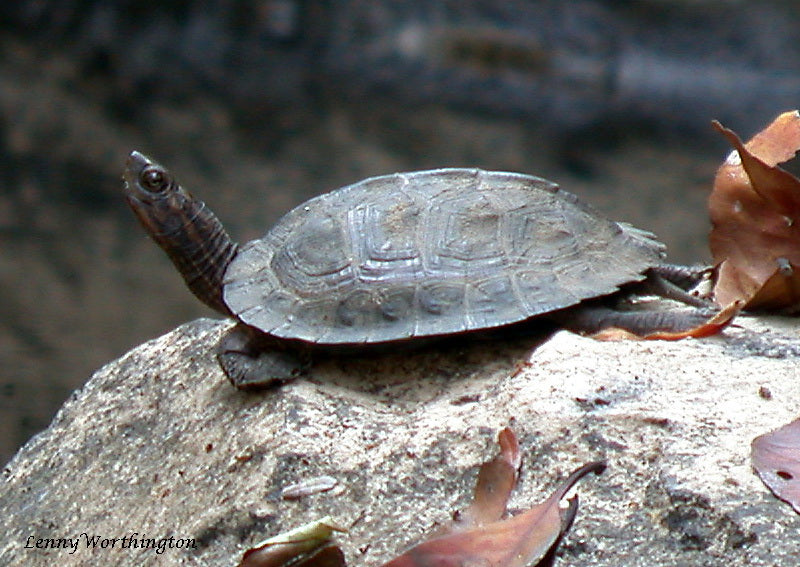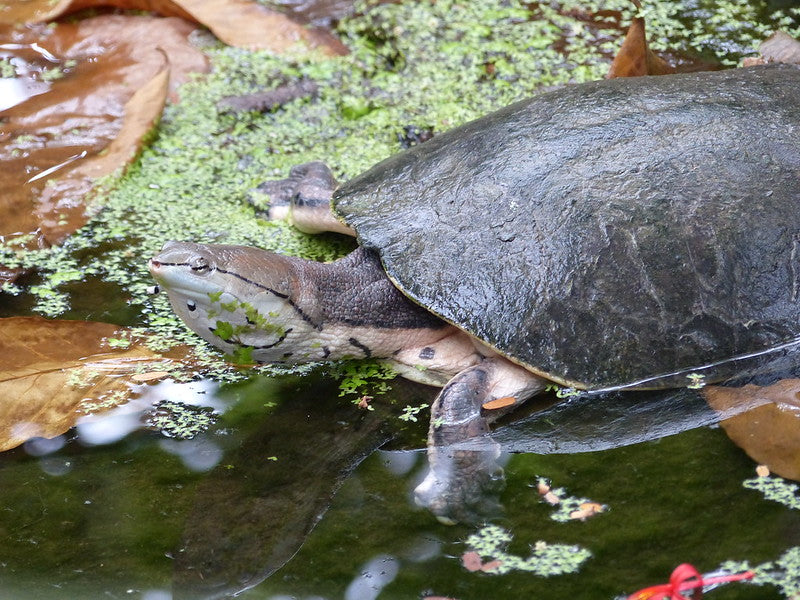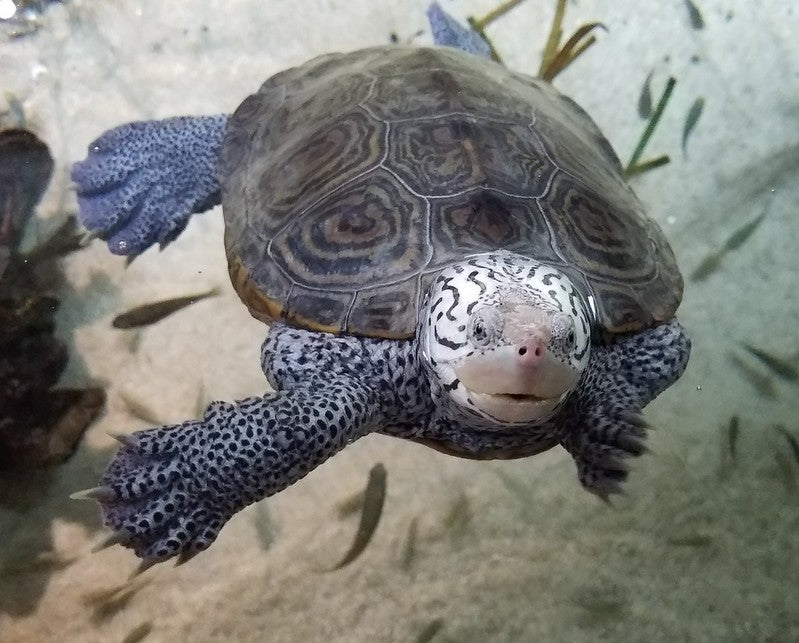Asian leaf turtles (Cyclemys dentata) are small, semiaquatic, diurnal reptiles native to southeast Asia. They prefer wet forest habitats, staying near bodies of fresh water such as streams, rivers, and ponds. Juveniles spend more time in the water than adults, but both have an amphibious lifestyle.
Asian leaf turtles grow to 6-9.5” long. They have large, prominent eyes, a boxy head, gently domed shell, and serrated posterior scutes. Appearance varies by population. The shell is reddish brown to brown-black, with similarly colored skin that may have lighter striped markings on the head and neck. The plastron may be pale, yellow, or orange, and may or may not have thin dark radiating stripes on each scute.
Most Asian leaf turtles are wild-caught, but they are becoming increasingly available captive-bred. As pets they are intermediate to advanced in difficulty.
How much space do Asian leaf turtles need?
An Asian leaf turtle should have an enclosure that offers both terrestrial and aquatic living space. The minimum appropriate enclosure for keeping one adult Asian leaf turtle should be around 100”L x 50”W x 30”H (8.25’ x 4’ x 2.5’) or 35 square feet. Juveniles under 6” long can be temporarily housed in smaller to get started. The enclosure should be about 50% shallow water and 50% moist land. However, this is just the minimum, and providing a larger enclosure is both beneficial and appreciated! Due to this species’ humidity needs, an open-top indoor enclosure is not appropriate.
Hatchlings and juveniles under 6” long don’t need much in the way of water depth: 2-4” is enough to get them started. For subadults and adults, however, this water depth should be increased to 6-8”. It’s best for the water area to be sloped in order to offer areas of shallower and deeper water for your pet to use as desired.
As with most chelonians, outdoor housing is ideal for this species’ health and wellbeing if you live in an appropriate climate. Even part of the year outside and part of the year inside is better than none at all! Outdoor enclosures must be predator-proofed and have walls that extend at least 6” underground to prevent burrowing escape.
Asian leaf turtles are not known to be naturally social or to benefit from being housed with other members of their species, so it’s best not to house Asian leaf turtles in groups if you are using a minimally-sized indoor setup.
Do Asian leaf turtles need UVB?
Asian leaf turtles require access to high-quality, low-intensity UVB in order to maintain optimal health and wellbeing. Providing UVB lighting to your turtle gives them all of the vitamin D that their body needs, stimulates better appetite and activity, and strengthens the immune system, as well as other benefits.
The best UVB bulbs for Asian leaf turtles are:
- Zoo Med Reptisun T5 HO 5.0
- Arcadia Forest 6%
The UVB bulb should be half the length of the enclosure and housed in a reflective fixture like the Arcadia ProT5 or Vivarium Electronics. Place the UVB close to the heat lamp so the two types of light overlap. If it’s on top of a screen lid, the basking platform should be placed so the top of the turtle’s shell is 7-9” below the lamp.
UVB bulbs decay over time, so don’t forget to replace your bulb every 12 months to maintain good performance. Lights should be on for 12 hours/day or synced with your local sunrise and sunset times.
Asian leaf turtles housed outdoors do not need supplementary UVB.
What basking temperatures do Asian leaf turtles need?
Asian leaf turtles are ectotherms, which means that they rely on the variable temperatures of their environment to help regulate their metabolism and stay healthy.
Temperature gradient for Asian leaf turtles:
- Basking area (air temp) — 90°F
- Ambient temperature — 76-80°F
- Nighttime temperature — 72-80°F
Measure basking temperature with a digital probe thermometer, with the probe placed on the basking surface.
A good way to warm the basking area is with a cluster of two 40-60w incandescent heat bulbs placed on one side of the enclosure and positioned over the basking surface. Heating should be turned off at night. Do not use ceramic heat emitters (CHEs), red bulbs, or blue bulbs, as these are not as effective. Increase the wattage if they’re too cool, and use a plug-in lamp dimmer or rheostat if they’re too warm.
According to average measurements from Asian leaf turtle habitat, if you plan to house your turtle outdoors, daytime temperatures should get no higher than 90°F, with nighttime temperatures no lower than 70°F. Plenty of shade must be always available.
What humidity levels do Asian leaf turtles need?
Asian leaf turtles should have an average daytime humidity of 80% and higher at night. As a forest species, they need consistently high humidity in their environment to stay healthy. Humidity should be measured by a digital probe hygrometer with the probe in the middle of the terrarium.
To help maintain high humidity levels, mist your enclosure 2x/day with a pressure sprayer and use a thick layer of humidity-retentive substrate with leaf litter. It’s also a good idea to provide humid hideouts lined with moistened substrate or sphagnum moss and placed in the middle to cool end of the enclosure.
How to maintain the water in an Asian leaf turtle enclosure?
Asian leaf turtles may prefer shallow water, but it should always be kept clean in order to keep your pet healthy. This means that you will need an appropriate filter and regular water changes.
Given that juveniles require such shallow water, it’s easiest to simply siphon out the water once a week, scrub the tray with veterinary disinfectant, and then refill. Once your pet is older and needs more space, this becomes less practical and you will need a filter. Calculate the maximum amount of water by multiplying length x width x depth of the pool, convert from cubic inches to gallons, then choose a canister filter accordingly. Don’t settle for the cheapest filter you can find — this is one aspect of your turtle’s enclosure not to skimp on!
Use a low flow aquarium filter designed for fish that prefer stagnant water, as musk turtles don’t like a strong current. If you can’t find something suitable, place a rock or similar directly under the filter’s output to disrupt the current.
Once every 1-2 weeks, remove and replace approximately 30% of the aquarium/pond’s total water volume. This helps minimize buildup of toxic compounds in the water that a filter is unable to resolve. To make the job easier, use a siphon.
Both indoor and outdoor turtle ponds require filtration and water changes.
What substrate is good for Asian leaf turtles?
Substrate is important for providing a burrowing medium for your turtle, as well as helping maintain appropriate humidity levels. Use a deep layer of moist, organic-rich soil for this area. You can do this with Zoo Med Reptisoil or Eco Earth, or by mixing your own substrate with approximately 60% clean topsoil and 40% coconut fiber (measured by volume). The substrate should be at least 2-4” deep depending on your turtle’s size and kept damp.
Spread leaf litter and sphagnum moss on top to complete the effect.
What décor can you use in an Asian leaf turtle enclosure?
Décor/”furniture” is essential to creating a functional enclosure for your pet. As a perk, these accessories also increase the enclosure’s general attractiveness! Here are some ideas:
- live/artificial plants
- driftwood
- hollow logs
- cork flats
- terracotta pots
As a forest species, having plenty of shade from foliage and other forms of cover is essential to keeping Asian leaf turtles relaxed and happy. Whatever you do, make sure the décor isn’t placed in a way that may facilitate escape.
What do Asian leaf turtles eat?
Asian leaf turtles are omnivorous, which means that they eat both animal and plant matter in order to get the nutrients that they need. Juveniles should be fed daily to every other day, while adults should be fed 2-3x/week depending on body condition.
Protein sources for Asian leaf turtles: dubias, discoids, earthworms, mealworms, snails, crickets, hornworms, silkworms, black soldier fly larvae, guppies, mollies, platies, mosquito fish
Fruits for Asian leaf turtles: figs, cherries, strawberries, raspberries, plums, watermelon, tomatoes, bananas
Food can be offered either on land or in the water. Prey and chopped fruit can be offered in a shallow bowl or plate on land, but aquatic turtle pellets should be offered in the water.
Supplements
You will also need calcium and vitamin supplements to prevent your turtle from developing a potential deficiency. Calcium can be easily provided by keeping a cuttlebone in the enclosure at all times for nibbling at will.
Turtle pellets such as Omega One Juvenile Turtle Pellets, Omega One Adult Turtle Sticks, Tetra ReptoMin, Zoo Med Natural Aquatic Turtle Food, Mazuri Aquatic Turtle Diet are appropriate to add to your pet’s dietary rotation for extra vitamins.
Do Asian leaf turtles like to be handled?
Asian leaf turtles are not particularly handleable, so it’s best to stay hands-off with this species. If you would like to interact with your pet, try hand-feeding them with a pair of soft-tipped feeding tongs.
*This care sheet contains only very basic information. Although it’s a good introduction, please do further research with high-quality sources to obtain additional information on caring for this species.
"Cyclemys dentata (Gray, 1831) Stream Terrapin" by LennyWorthington is licensed under CC BY-SA 2.0.




Leave a comment
This site is protected by hCaptcha and the hCaptcha Privacy Policy and Terms of Service apply.